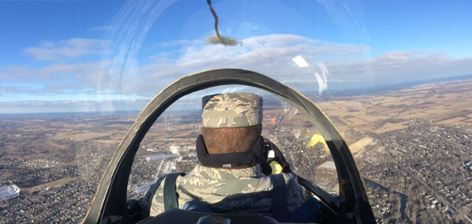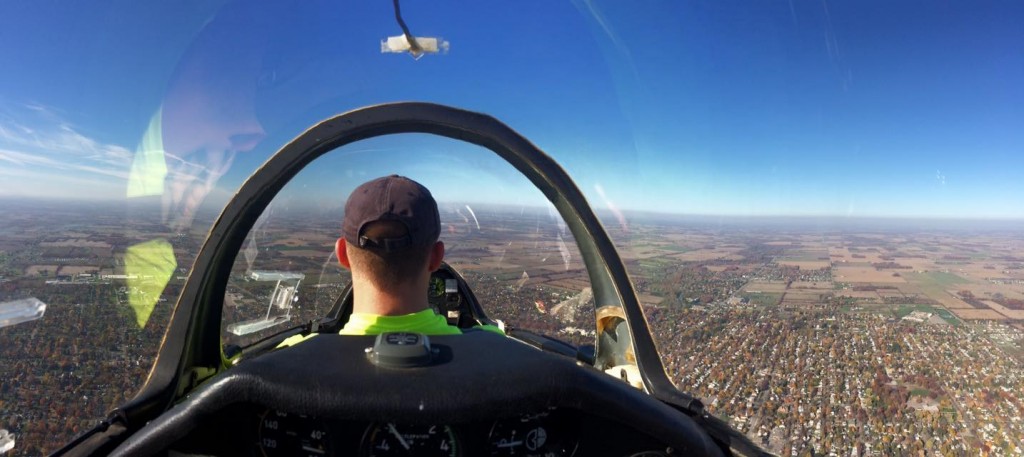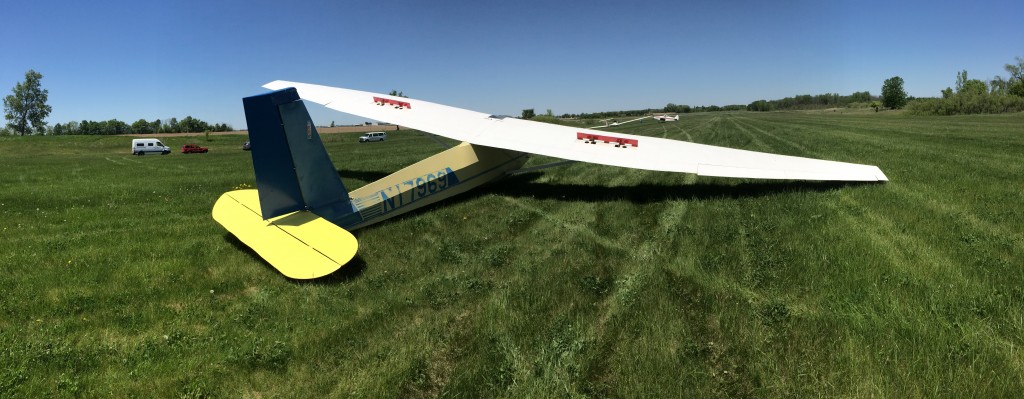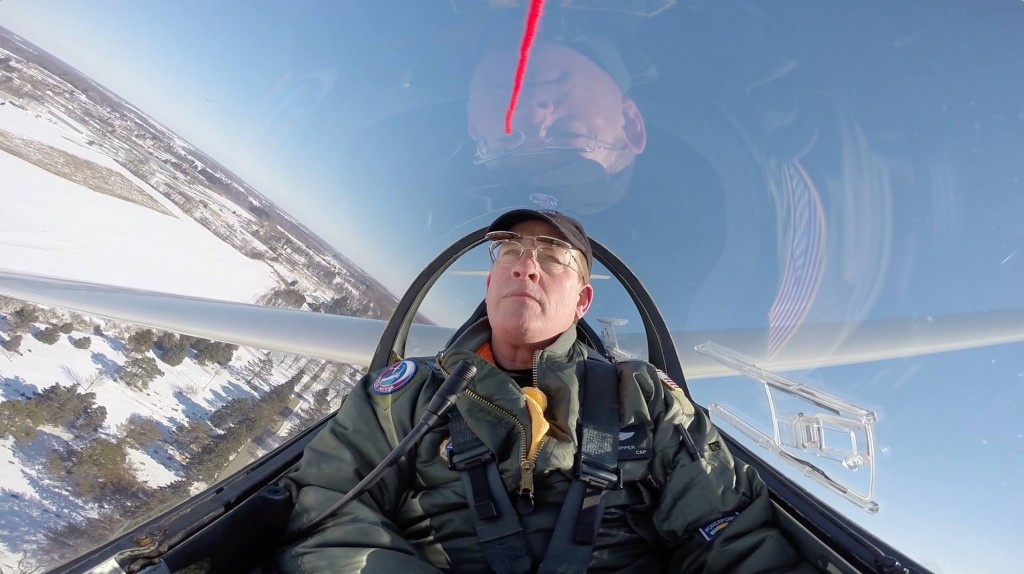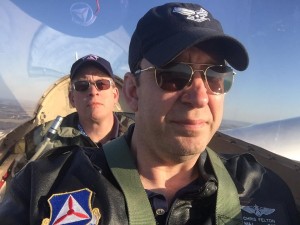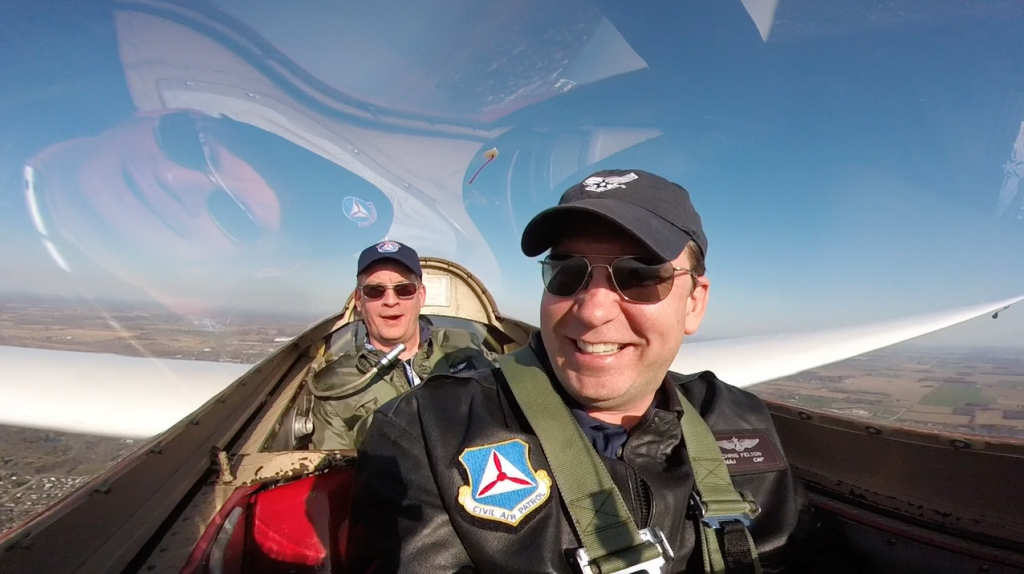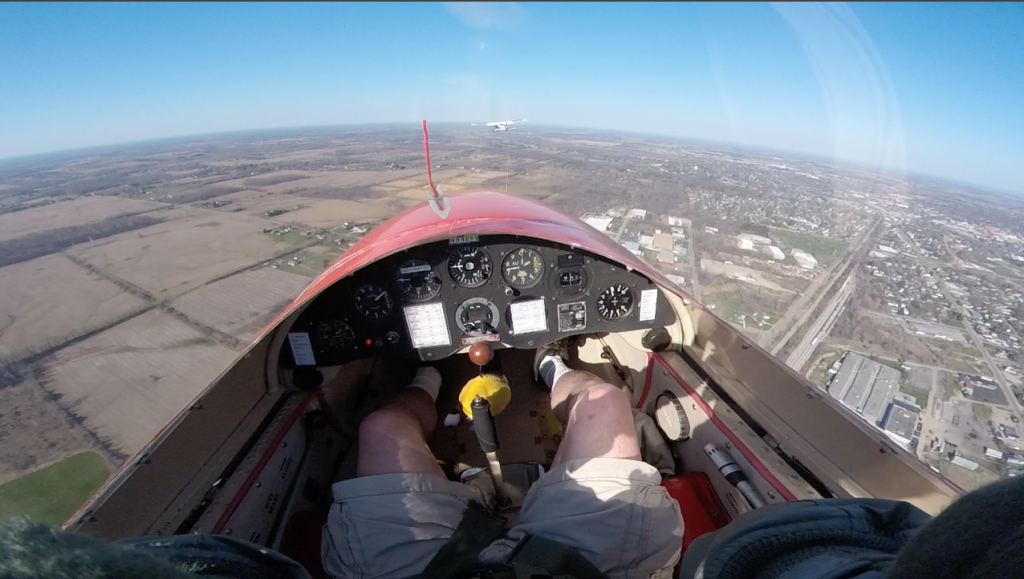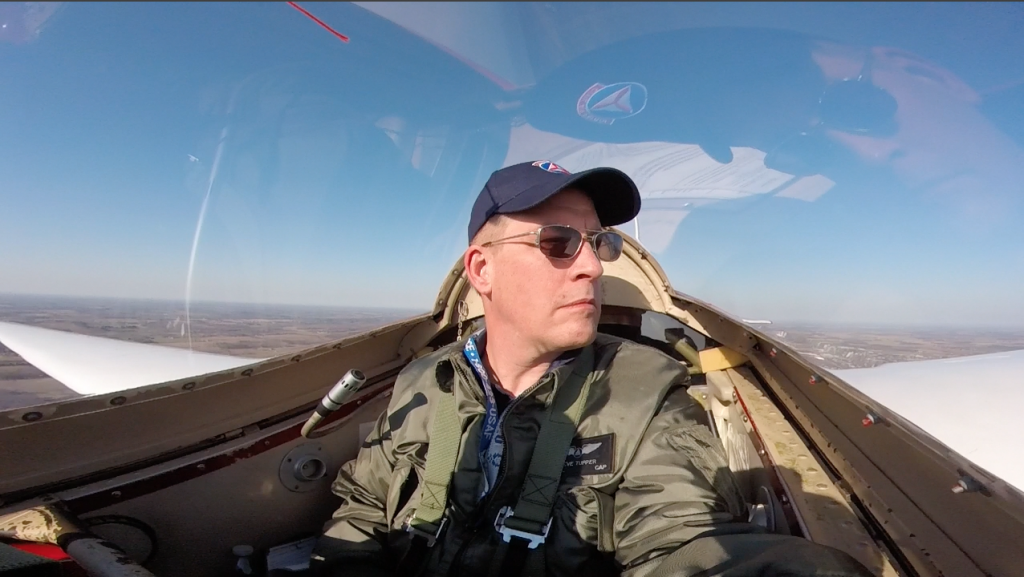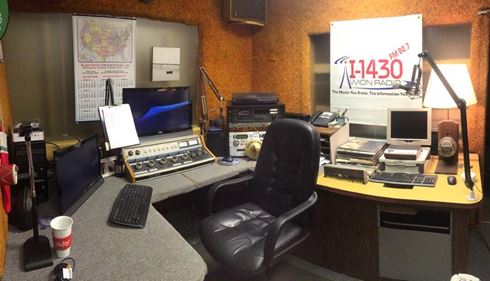I spent yesterday at the Owosso airport (KRNP) in the fashion that is becoming ever more frequent: As a an instructor pilot for Civil Air Patrol’s glider program.
Michigan Wing has one of the most active glider programs in the country. This despite the fact that Michigan’s weather is not always hospitable to glider operations. We fly year-round, sometimes in single-digit temperatures that require bundling up like the Michelin Man and changing chemical heaters in our boots and gloves at least once in the middle of flight operations. The result is that we often rank at or near the top nationally in terms of cadet orientation flights, as well as cadet flight training.
We operate two gliders: A Schleicher ASK 21 (TG-9A) and a Schweizer SGS 2-32 (TG-5). Both types operated at the U.S. Air Force Academy and we know that the N975AF airframe itself was there. We have two regularly active instructor pilots, a third IP who participates when he can, and a fourth pilot who flies orientation rides and doubles as a tow pilot. We have two frequent tow pilots and several others who tow as they’re able.
I frequently get strange looks from those who hear about MIWG glider ops. And those strange looks are deserved. But days like yesterday make it all worthwhile.
Temps started out at -9C and stayed below 0C all day. Cloud cover ranged from few to broken at around 4,000 AGL and winds were pretty consistently down Runway 29 at 12G18. But, to everyone’s surprise, we found lift. Lots of lift, in fact. We hit four to six knots up pretty consistently and, although there was some corresponding sink, we had enough to keep us up for much longer than the usual 0.3 from launch to landing.
To be sure, we can do everything that we need to do for a cadet orientation flight within that timeframe. But a little additional time allows us to let the cadets fly longer and spend more time demonstrating altitude-eating maneuvers like steep turns. Even an additional 0.1 or an extra few hundred feet make a big difference.
I flew 13 sorties: Two C16 flights with FOD (and would have re-soloed him if the winds weren’t above CAP cadet solo limitations), two C12 flights with senior members, and nine A15 cadet orientation flights.
Nicholas “FOD” Tupper is flying very well. Other than talking briefly on the radio to ask an incoming CAP airplane to give him room to get in and land, I was baggage there in the back seat. When I get bored, it’s time to get out of the glider and let the C/2Lt ply the skies without all that weight and noise in the back seat. I’m unspeakably proud of what he’s done since his first flight with me in 2012, and especially as certificated student pilot since last year.
The C12 flights with senior members are fun. First, during winter operations, you only get the senior members who really want to fly. They’ll come out and stand in the cold all day launching and retrieving gliders and supervising cadets just to get a flight.
Most senior members like that are in it for the stick time. I don’t disappoint them. For one of them, I fly the takeoff and tow and he takes the controls from release until downwind. For the other, today was the first time I let him fly from takeoff to landing. I learn things when I fly with guys like the second one. He’s nervous and uptight. From the back seat, I can see his shoulders up in his ears from the time he straps in.
We got the bird in the air on the takeoff roll and immediately shot laterally to the left. “Um, help me on this?” No problem. Boot a little rudder, get us back behind the tow, and hand it back to him. Off we go to the left again. Lather, rinse, repeat. Then we’re up above 200 AGL (the safe return altitude after which it would be really hard to get hurt in a glider) and he’s finding his way on tow. Pretty consistently high, low, left, and right. Shoulders in his ears. But it’s best to let him figure stuff out.
As an IP, I’m finally developing a decent sense of how far I can let a student get away from where he or she is supposed to be before intervening. This is important. Correcting from error is a valuable process in which the student teaches himself or herself about flying. If I’m on the controls more than I need to be, I’m depriving the student of that valuable experience. My job is to sit there and protect everybody (the student, the tow pilot, and me) from Bad Things while providing a sandbox in which the student can play.
Neither of the senior members has yet found his feet. As a budding aerobatic, then glider, pilot, I did my share of uncoordinated flying. This is the universe’s way of revisiting my early training on me. It’s not uncommon to be sitting in the back seat, forced into one side or other other of the glider as the student has a wing down and no corresponding rudder. (Or pull to make the turn happen. You just kind of sit there uncoordinated and see the puzzlement exuding from the back of the student’s head.)
But that’s okay. Here’s my view: We tell students that these controls have such-and-such effects. But the students initially have no kinesthetic sense of how much of what input does what or how inputs combine to give the desired effect. It’s only right to let them get up in the sky and try out those controls. I’m absolutely fine with a student thrashing all over the sky. When they get it, they’re really going to get it. And I expect that it’ll happen suddenly and neither of them will actually know why. It’ll suddenly just feel right and they’ll be doing what they’re supposed to do.
“The glider already knows how to fly. The sooner you get out of the glider’s way and let it do what it wants to do, the better your results.” Yes, some jerk said those words to me. And I now regularly say them to the senior-member students. They’re true, even if a little frustrating at first.
Cadet orientation flights were the mixed bag that they usually are. All good, but a mixed bag. Cadets show up feeling everything from unbounded enthusiasm to abject terror. As an orientation pilot, you have about five minutes to size up each cadet. You see him or her step to the glider, you get his or her name, CAP ID, and weight, and then you see the backs of their heads from the time they strap in until the time they unstrap.
You owe each cadet an orientation flight that teaches what the syllabus says to teach while reaching out to the cadet where he or she is. A cadet who’s terrified, but doesn’t want to show fear in front of his or her fellows, needs a ride that’s going to get him or her back to the airport for the next ride. No shucking or jiving. Talk in soothing tones. Explain everything. On the other hand, a cadet who’s on his or her fourth flight and wants to see big turning stalls again is going to get another kind of flight entirely.
I had a cadet today who among those that make brutal cold, withering heat, and lots of Saturdays more than worthwhile. We have a policy soft spot for 17-year-old cadets who are about to age out of eligibility for orientation flights. If they show up, we make every effort to get all of their O-flights in under the wire. That sometimes means that we’re flying that cadet as much as five times that day. Today’s was one such cadet who had four flights to go.
On the first flight with her, I ran into nothing but sink. 4-6 knots of it wherever I turned. We eked out Syllabus 2, but after we came to a stop on the runway, I apologized to her. Then, on the next tow, we hit lift.
Like I said, lift is time and options. Even an additional six minutes or a few hundred feet means additional opportunities to teach and let the cadet explore the envelope. We rapidly found ourselves at 4,100 and about 500 feet below the clouds. Syllabus 3 is where you introduce stalls, so this seemed to be a good point at which to lay off the thermals and let the relative wind see the bottoms of the wings.
I demonstrated a basic stall, then let her fly one of her own, which she accomplished perfectly. She had done well on the first flight of the day, so I thought it appropriate to go a little further than I otherwise might. I showed her a stall with a much higher deck angle at the break (maybe 20 degrees), which tends to result in a pronounced break and a good 30 degrees of pitch down at the conclusion. And she yelled and laughed Well, a yell and a laugh in my ship is going to get you the opportunity to fly your own stall like that. So she took the controls and pitched for the stall. And pitched. And pitched. Hmmmm . . .
When the break came, the nose pitched precipitously and I noticed that there was considerably less than 1G on the seat. Quite considerably. And considerably more planet in the windshield than I was accustomed to seeing. As we pulled out (to the sound of laughter and other positive noises from both seats), it occurred to me that the overall effect was much more like a pull-push-pull Humpty Bump than a stall and recovery. All safe and well within the capabilities of aircraft and aircrew, but nevertheless an experience to throw into the flight bag for future reference.
On the third flight of the day, we really got into the lift. It was everywhere. It was like shooting fish in a barrel. We’d pick a direction to fly with zero sink for a minute at a time, then get a kick in the pants and be hard-over into four to six knots of lift. We got right up to the cloud bases again, this time with me giving spoken suggestions, but her doing all of the flying. It was the fastest I’d ever seen someone develop an intuitive sense of how to thermal.
After nearly a half hour, I decided that we needed to get back on the ground. There was a reasonably deep stack of cadets who still needed to fly and I wanted her to have a chance to fly the other glider as well. When faced with extra altitude, I take it as license to practice those maneuvers that eat altitude, here meaning steep turns.
I talked her over to an area where it was clear below and clear laterally of the other glider, then demonstrated a 45-degree steep turn. She took the controls in the turn and, with the nose bobbing a little and some airspeed excursions, she got it going around pretty well. We leveled out and then I put us in a 60-degree commercial steep turn going the other way. Once established, I pulled to +2G, as befits that bank angle. The noise from the front seat was what every IP hopes for. I gave her the controls and she kept the commercial-grade steeps coming as we came out of the sky like a hot set of car keys. Recovering a little before 1,500 AGL, I took the controls and got us on the ground.
Like I said, yesterday was one of those days that make all of the cold, the heat, and the work worthwhile. 13 total sorties for 4.3 hours. And lift that the other IP (a 10,000+ flight glider guy) said that he’d never seen before in those kinds of conditions.
Aviation frequently brings on the feeling of disbelief that they let us do things like this. We feel like we’re getting away with something every time we show up at the airport, raise the hangar door, and see the birds sitting there in the pre-dawn light as the tow plane taxis onto the ramp behind us.
Of course, we’ve paid for this many times over, we hold ourselves to brutally high standards, and we’re not “getting away with” jack. But it’s not hard on a day like yesterday to feel like we do.
